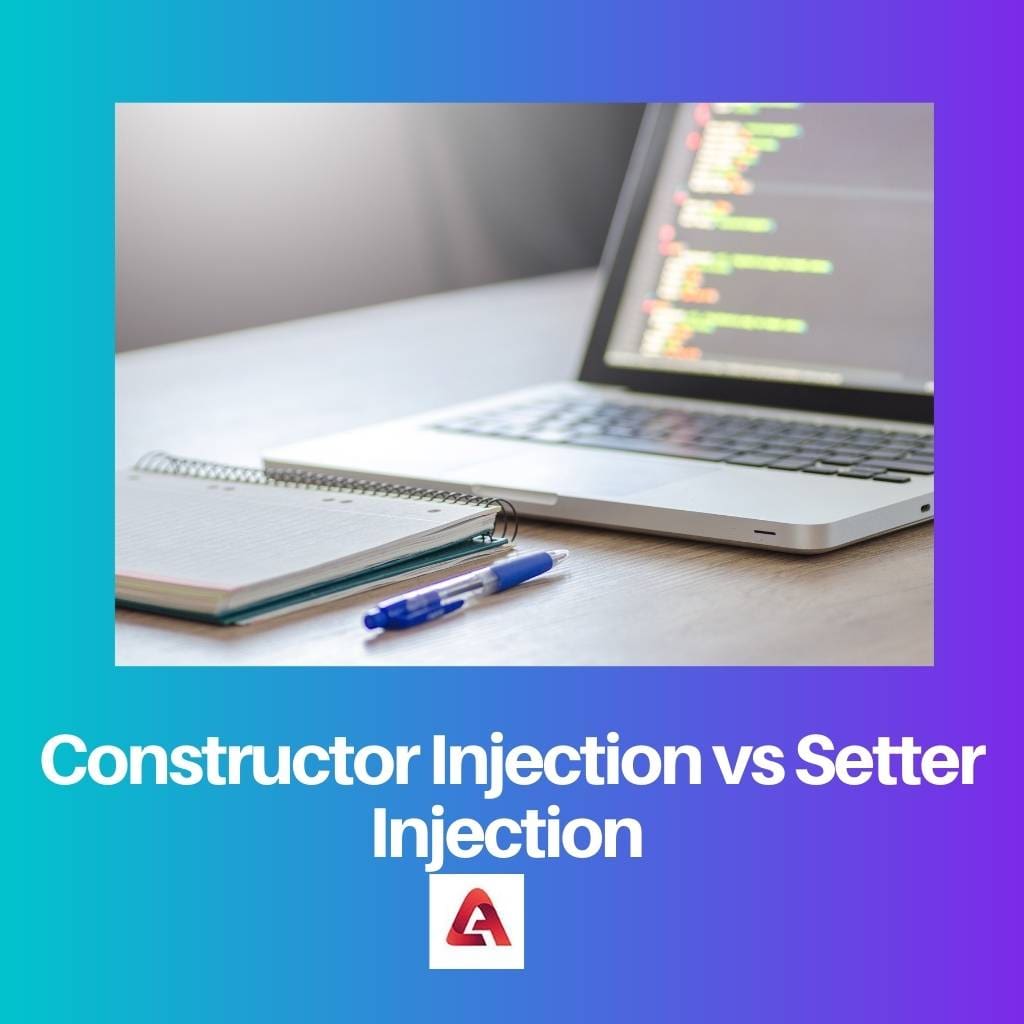When dependency resolution is made by an external agent rather than the class itself, then it is known as dependency injection.
There are two standard ways of dependency injection that are being supported in the Spring framework, through a constructor argument or via using the setter method.
The former type of dependency injection is known as the constructor injection, and the latter is known as the setter injection. Both methods are used for different purposes and have their own pros and cons.
Key Takeaways
- Constructor injection ensures complete object creation with all dependencies; setter injection allows partial object creation.
- Constructor injection promotes immutability; setter injection allows for mutable objects.
- Constructor injection prevents circular dependencies; setter injection can lead to circular dependencies.
Constructor Injection vs Setter Injection
Constructor injection is a type of dependency injection in the spring framework that uses a constructor to inject dependency. A setter injection is a type of dependency injection in the spring framework that uses setter methods to inject dependency. It can inject partial dependency and is more flexible.

Constructor injection is a type of dependency injection in the spring framework that uses a constructor to inject dependency. The dependencies that are required for any of the classes are specified as the parameters of that specific class’s constructor.
Constructor injection does not allow the developer to construct any object unless all the dependencies are ready, and thus, it ensures successful dependency injection.
Setter injection is a type of dependency injection in the spring framework that uses setter methods to inject dependency. It has setter methods of the form set XYZ (), where XYZ denotes a dependency that injects the dependent objects into the client.
This way of resolving the dependency is very common in the Spring framework.
Comparison Table
| Parameters of Comparison | Constructor Injection | Setter Injection |
|---|---|---|
| Dependency injected | It uses a constructor. | It uses setter methods. |
| Readability | It is not much readable in comparison to the setter. | It is more readable. |
| Override property | Cannot override dependency. | Can override certain dependencies. |
| Changes | It always creates a new bean instance. | It does not create any new bean instance. |
| Immutability | It supports immutability. | It does not support. |
What is Constructor Injection?
Constructor injection is one of the standard ways of resolving dependency within the Spring framework, which statically defines the list of dependencies required for classes by assigning those as the parameters to the class’s constructor.
All the classes that require dependency must have a public constructor inside them, which takes an instance as the constructor argument, and that constructor should necessarily be the only public constructor inside that class.
If there is a need for more than one dependency, then the additional arguments should be added to the same constructor. A single responsibility principle should be followed to ensure that the dependency is injected completely, which states that members should do only one thing.
The constructor should be kept free from any other logic to make the constructor of the classes faster and more reliable.
One important fact of constructor injection is that the objects won’t be constructed unless all the dependencies are ready. As it creates new instances every time the constructor is being called thus, overriding is not possible in it.
Constructor injection is basically used in cases when there is a necessity to create objects with all of the dependencies. This is the most applicable and easiest way to implement dependencies correctly.

What is Setter Injection?
Setter injection is one of the standard ways of resolving dependency within the Spring framework, which uses the setter methods to resolve the dependencies. The setter methods are of the form set XYZ (), where XYZ specifies the dependency that needs to be injected.
In this type of injection method, first, the object is created, and later on, the dependency is injected. For configuring Spring, XML files are used; thus, readability is a big concern.
As setter methods have a specified form of method names, it enhances readability in many ways. When there is a need to inject a larger number of dependencies, then the setter injection type is very favored and preferred over other types of injection methods.
In addition to that, by using setter injection, the developers can easily override and change the values because it does not create a new bean instance every time. The only drawback of setter injection is that it does not ensure complete dependency injection.
There is no guarantee as to whether a certain object has dependency injected or not. In other words, it means that there might be an object with incomplete dependency. Setter injection is the most flexible and most common way of implementing dependency injection.

Main Differences Between Constructor Injection and Setter Injection
- When constructor injection is used to inject the dependency, it is done by using a constructor on any Spring-managed bean, whereas the Setter injection uses setter methods like set dependency() for the purpose of injecting dependency on any of the bean-managed by the Spring’s IOC container.
- Setter injection is more readable in comparison to the constructor injection as the setter method always has names starting with the word set like setXYZ(), and thus, it is easy to read in the Spring XML config file and interpret the dependency that is being set whereas the Constructor injection uses an index for the purpose of injecting dependency.
- Certain dependencies can be overridden using the setter injection, whereas this is not possible by using the constructor injection as every time a new object is created when the constructor is called.
- By using the setter injection, the value can easily be changed as it does not create any new bean instances, whereas that is not the case while using the constructor injection because it always creates a new bean instance.
- Constructor injection supports immutability, whereas on the other hand, setter injection, does not support immutability.
- https://digitalcommons.calpoly.edu/csse_fac/34/
- https://books.google.com/books?hl=en&lr=&id=InfRDwAAQBAJ&oi=fnd&pg=PA63&dq=constructor+injection&ots=Hon_bCw-Kv&sig=VdsD_S0lCfP3D8idI8q4F6RnhoE

The explanations of constructor and setter injections highlight the importance of properly managing object dependencies for robust and maintainable software development.
Indeed, Vcox. Careful consideration of dependency injection methods is essential to ensure the long-term viability and maintainability of software systems.
Well articulated, Vcox. Managing dependencies effectively is a critical aspect of developing scalable and maintainable applications.
The detailed information on constructor and setter injections provides developers with a robust understanding of how to manage dependencies effectively in Spring framework applications.
Spot on, Rogers Natasha. Understanding the intricacies of dependency injection methods is crucial for maintaining clean and scalable codebases.
It’s fascinating how constructor and setter injections offer different levels of support for immutability and circular dependencies, impacting the design and behavior of the application.
Absolutely, Christian13. The potential for circular dependencies and object immutability should be central considerations when choosing a dependency injection method.
I couldn’t agree more, Christian13. The implications of these differences on the overall system architecture are substantial and must be carefully considered.
The comparison table provides a concise overview of the pros and cons of constructor and setter injection, making it easier to decide which one to use in different contexts.
Absolutely, Amorris. It’s essential to weigh the trade-offs between immutability, readability, and completeness of object creation when choosing the injection method.
I appreciate the detailed comparison. It helps developers make informed decisions based on the specific requirements of the application.
The in-depth explanations of constructor and setter injections provide valuable insights into the differences and use cases of each approach.
Well said, Darren. Understanding the fundamental concepts and implications of dependency injection methods is crucial for developers to build robust and maintainable systems.
The detailed explanations of constructor and setter injections shed light on the trade-offs between completeness of object creation and flexibility in managing dependencies.
Absolutely, Eden60. Balancing completeness and flexibility in dependency injection is crucial for developing scalable and maintainable software applications.
Nicely summarized, Eden60. Understanding these trade-offs is essential for making informed decisions about the design and architecture of software systems.
The comparison between constructor and setter injections provides developers with a clear understanding of the implications of each method on the overall design and behavior of the application.
Well said, Flee. Understanding the implications of different dependency injection methods is crucial for developing robust and maintainable software solutions.
The comparison of constructor and setter injections makes it clear that both approaches have distinct advantages and implications on the overall design and behavior of the application.
Absolutely, Qrogers. It’s essential to evaluate the specific requirements and implications of each injection method to make informed design decisions.
The in-depth explanations of constructor and setter injections provide developers with valuable insights into how to design and manage complex dependencies effectively.
Well put, Archie30. Having a thorough understanding of dependency injection methods is crucial for designing robust and maintainable software architectures.
Great explanation! Both methods of dependency injection have their advantages and drawbacks that must be carefully considered in each project.
I agree, Ava. Constructor injection is a great choice when it’s necessary to ensure complete object creation with all dependencies, whereas setter injection is more flexible but doesn’t guarantee complete dependency injection.
Thank you for the clear explanation. It’s important to evaluate the specific needs of the project to determine the most appropriate method of dependency injection.